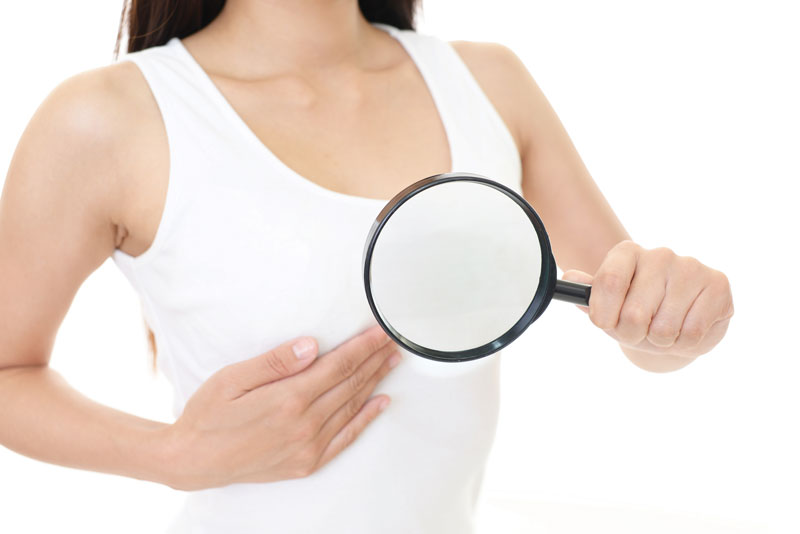Try Thermography for Safe & Painless Breast Screening
 Welcome to the New Year! For me, it’s a time for reflection and assessing which path I’d like to be on in regards to my health, especially when it comes to prevention.
Welcome to the New Year! For me, it’s a time for reflection and assessing which path I’d like to be on in regards to my health, especially when it comes to prevention.
One method of prevention that everyone should consider is thermography. For those of you not familiar with the term thermography, it’s a means of assessing any area of the body via a heat-sensitive camera. The human body constantly gives off heat to maintain a stable body temperature. An infrared camera detects and translates that heat into an image. The camera operates much like a regular camera but instead of capturing light, the camera captures heat, creating an image that looks quite like a colored topographical map; hot areas displayed in white and red, warm areas appear orange and yellow and cooler areas in various greens and blues.
There is so much in the media today on the effects of inflammation on the body but there doesn’t seem to be a great way to locate that heat…enter thermography: a safe, painless, noninvasive tool that is highly sensitive to subtle differences in skin surface temperature.
Unlike most screening modalities, thermography is non-invasive. It uses no radiation, injections or compression to achieve its images. It is a sensitive and reliable means of graphically mapping and displaying skin surface temperature. Thermography can be used to screen, evaluate, monitor and document a large number of injuries and conditions such as: endometriosis, pre-diabetes, back injuries, arthritis, fibromyalgia, vascular disease and digestive disorders to name a few.
Breast Screening
The benefit of thermography in breast screening is that it offers the opportunity of earlier detection of breast disease than has been possible through breast self examination, doctor examination or mammography alone. Thermography detects the subtle physiologic changes that accompany breast pathology, whether it is cancer, fibrocystic disease, an infection or a vascular disease.
The protocol for breast screening includes five images: one from the front, one from each side (arms raised to include armpits and lymph area), and one from each oblique angle. The procedure is quick and painless, comparable to being photographed. Initially, two screenings 3 months apart generally establish a thermal baseline. After that, an annual screening is sufficient.
All women can benefit from thermography. Younger women can start screening safely in their 20’s and 30’s, older women who still have dense breast tissue will find this means effective, and women who have already had a mastectomy can safely and accurately continue to monitor the affected region.
Some women have serious concerns about the cumulative effects of radiation and want to limit their exposure. Thermography allows them to monitor their breast health without the risk of additional radiation exposure.
Thermography or Mammography
Thermography is not meant to replace mammograms. Mammograms and thermograms are completely different screening tools; one does not replace the other. The mammograms are a means of anatomical screening; they are looking for densities such as calcifications, lumps, cysts, etc.
Thermograms are a physiological assessment; looking for lymphatic congestion in the region of the arm pits, estrogen dominance or simply providing insight for women with dense breasts. Lymphatic congestion and estrogen dominance are early indicators that the breast is not in a healthy state. The good news is that something can be done about both of these breast issues.
- Lymphatic congestion is frequently seen via thermal indications and if this diagnosis is made then it’s a comfort to know a referral can be made to a handful of specially trained experts in lymphatic drainage therapy in the state. Fortunately, we can determine if the treatment was effective with follow-up thermal images after lymphatic therapy sessions.
- Estrogen dominance or elevated estrogen levels are a risk factor for breast cancer. This condition can be helped with hormone intervention and the avoidance of xenoestrogen exposure related to plastics, food additives, household cleaning products and pesticides to name a few.
- “I have dense breasts.” That is a common statement with the implication that a mammogram does not deal effectively with dense breast tissue. In fact, many mammogram reports now come with a ‘dense breast disclaimer’. However, increased breast density enhances lifetime risk for breast cancer. This is a perfect reason for the addition of thermal imaging to the screening protocol. Because thermography assesses by means of measuring skin surface temperature, dense breast tissue can be read as effectively as non-dense tissue.
Thermography, when used in conjunction with mammography and clinical breast exams, gives the patient the opportunity to make decisions with as much information as possible. One study published in the American Journal of Radiology in 2003 demonstrated that thermography had a 97% sensitivity in distinguishing benign from malignant growths. The conclusion stated: “Infrared imaging offers a safe, noninvasive procedure that would be valuable as an adjunct to mammography in determining whether a lesion is benign or malignant”.
The information gleaned from a thermography report is particularly helpful for prevention-minded people who are willing to make dietary or behavioral changes to begin to correct some imbalances in the body. People are now realizing that thermography is not just for women and it’s not just for breasts. More on the range of thermography’s usefulness will be focused on in a future article.
Ingrid LeVasseur, BA, is a certified clinical thermographer who received her training at Duke University in 2006. She has been a teacher of meditation for over 30 years and spent four years teaching meditation under the medical direction of Dr. Deepak Chopra. As the owner of Inner Image Clinical Thermography in Falmouth, Maine, Ingrid offers thermography to hundreds of prevention-minded individuals in southern Maine. She can be reached at 207-781-6060 or through her web site at: www.MyInnerImage.com or via email at: [email protected].




